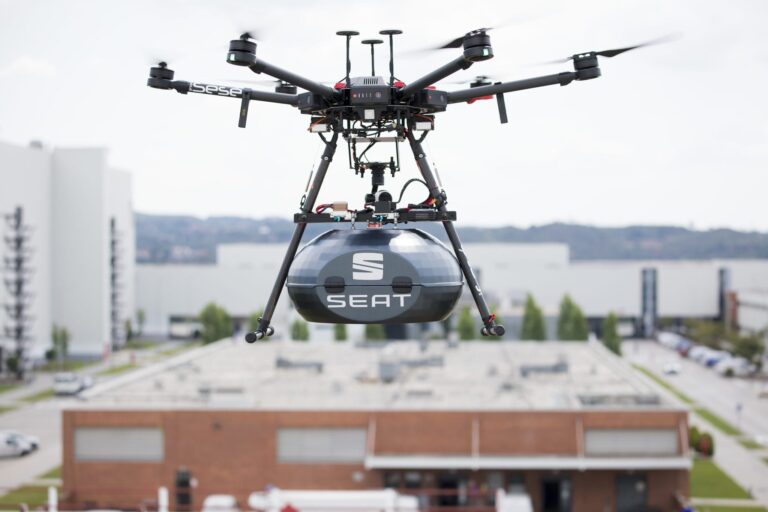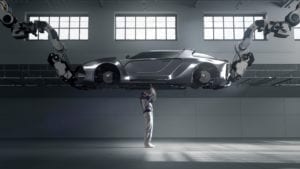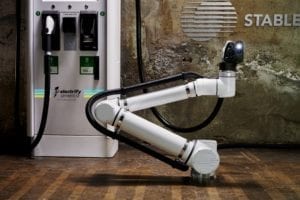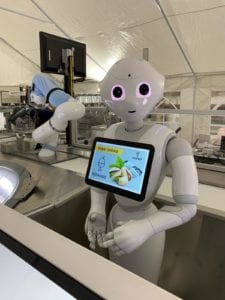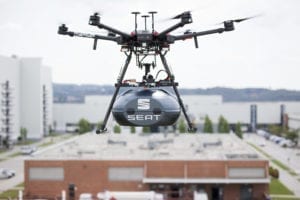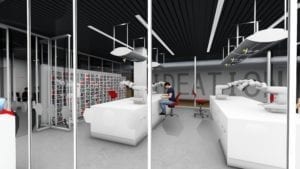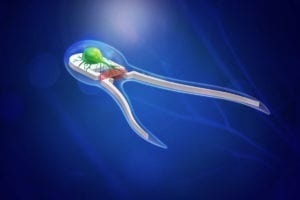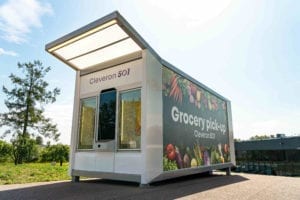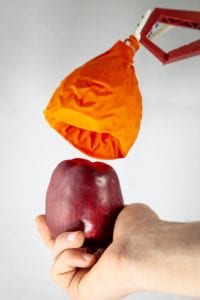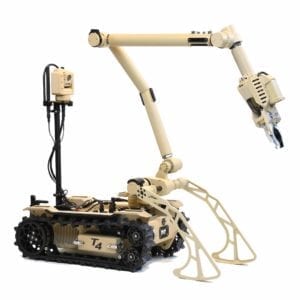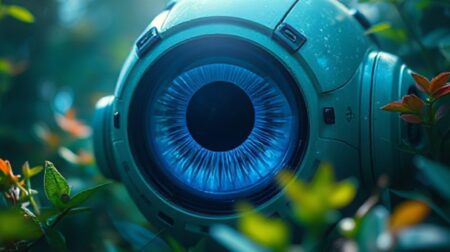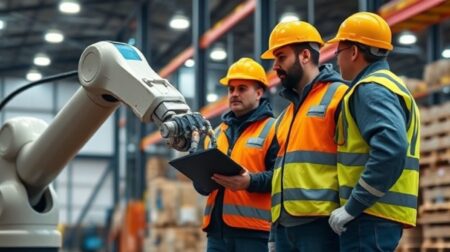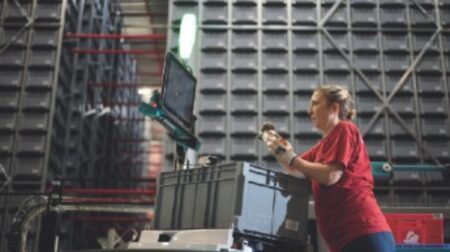From humanoid ice cream attendants and flying fish to origami-inspired grippers, John Thornton rounds up the 10 most innovative robotics and automation technologies released so far this year…
Wearable vest exoskeleton
Hyundai Motor Group’s wearable robot – dubbed the Vest EXoskeleton (VEX) – assists production-line workers whose job is primarily overhead, such as bolting the underside of vehicles, fitting brake tubes, and attaching exhausts. The VEX is designed to enhance productivity and reduce fatigue of industrial workers by imitating the movement of human joints to boost load support and mobility.
The wearable vest features a polycentric axis combining multiple pivot points with multi-link muscular assistance to function, eliminating the need for a battery. At 2.5kg, the VEX weighs 22-42% less than competing products and is worn like a backpack. The back section can adjust in length by up to 18cm to fit a variety of body sizes, while the degree of force assistance can be adjusted over six levels – up to as much as 5.5kg.
The VEX is expected to go into commercial production in December and is projected to cost some 30% lower than existing products, which usually cost around US$5,000.
Robotic EV fast-charging system
Electrify America and EV fleet charging company Stable Auto have developed a robotic charging solution for self-driving electric vehicles.
The system, which sees a robotic solution from Stable Auto attached to a 150kW DC fast charger from Electrify America, has been developed to eradicate the need for human intervention during charging of autonomous EVs and to address the absence of dedicated charging facilities equipped for such vehicles.
Located at a site in San Francisco, California, USA, the dedicated fleet-charging facility allows self-driving EVs to park themselves anywhere inside a standard parking space before a robot automates the connection between the vehicle and the charger.
Robotic ice cream attendants
Niska, an Australian start-up company pioneering retail robotics, brought retail robotics to Australia for the first time in September with its innovative ice-cream store.
Open in Melbourne, Niska offers gourmet and artisan ice-cream served by robot attendants Pepper, Eka and Tony. All three robots harness advanced robotic technology to create an innovative customer experience filled with interactions from the moment a customer steps into the store.
Humanoid robot Pepper was created by Japan’s SoftBank Robotics to serve as a type of kiosk at shops, hospitals and airports. It can track eye contact, express emotion and even have simple conversations with people. Eka is a robot arm with seven axes of movement that scoops the ice cream into cups, while Tony, which has two arms and a digital screen acting as a face, pours chocolate on top of the scoop.
Industrial drone delivery service
In July, SEAT’s manufacturing facility in Martorell became the first Spanish plant to receive components via drone delivery.
The first-ever parts delivery service between Grupo Sesé’s logistics centre in Abrera and the SEAT factory in Martorell by drone was made on July 10th and has since continued with several flights per day of deliveries of steering wheels and airbags to the SEAT assembly lines.
The addition of drones has already improved flexibility on SEAT’s production lines by connecting the just over 2km (1.2-mile) distance that separates both facilities for just-in-time fast deliveries in only 15 minutes, a process which is currently done by truck and takes 90 minutes.
Delivery using drones represents a reduction in CO2 emissions compared to truck transport and in addition, the drone’s batteries are recharged using renewable energy.
Flying fish robot
Researchers at Imperial College London have invented a bio-inspired fish-like robot that uses water from the environment to create a gas and launch itself from the water’s surface.
The robot, which can travel 26m (85ft) through the air after take-off, could be used to collect water samples in hazardous and cluttered environments, such as during flooding or when monitoring ocean pollution.
Robots that can transition from water to air are desirable in these situations, but the launch requires a lot of power, which has been difficult to achieve in small robots. However, this system requires just 0.2 grams of calcium carbide powder in a combustion chamber. The only moving part is a small pump that brings in water from the environment the robot is sat in.
The water and calcium-carbide powder then combine in a reaction chamber, producing a burnable acetylene gas. As the gas ignites and expands, it generates a force 25 times the robot’s weight and pushes the water out as a jet, which propels the robot clear of the water and into a glide.
The robot, which weighs 160g, can ‘jump’ multiple times after refilling its water tank. This could allow it to float on water and take samples at multiple points without additional power, saving energy over longer distances compared to an electrically powered robot.
Non-surgical medical robots
ABB’s first-ever dedicated healthcare hub, located at the Texas Medical Center (TMC) innovation campus in Houston, Texas, USA, features non-surgical medical robots that undertake a range of repetitive, delicate and time-consuming activities.
The use of non-surgical medical robots to automate repetitive and low value tasks such as dosing, mixing and pipetting, as well as sterile instrument kitting and centrifuge loading and unloading, has enabled TMC’s medical professionals to focus on more highly skilled and productive work, and ultimately help more people to receive treatment by dramatically speeding testing processes. TMC has found that ABB’s collaborative robots are well suited to its medical facility due to not requiring safety fences to operate safely and efficiently alongside people.
Encouragingly for the medical sector, ABB estimates that 50% more tests could be carried out every year using automation, while training robots to undertake repetitive processes should reduce the need for people to do tasks that cause repetitive strain injury.
Microscopic biohybrid robots
Researchers at the University of Illinois have developed soft robotic devices driven by neuromuscular tissue that triggers when stimulated by light – bringing mechanical engineering one step closer to developing autonomous biobots.
These two-tailed bots are powered by skeletal muscle tissue stimulated by on-board motor neurons. The neurons have optogenetic properties, which means that, upon exposure to light, the neurons fire to actuate the muscles.
This advancement could lead to the development of multicellular engineered living systems with the ability to respond intelligently to environmental cues for applications in bioengineering, medicine and self-healing materials technologies.
Robotic grocery pickup kiosk
In August, last-mile robotics solutions provider Cleveron launched Cleveron 501, a new grocery robot that enables grocery pickup in just 20 seconds. With Cleveron 501 users can pick up their everyday groceries in places where previously unattainable – such as in business districts – where there is not enough room for supermarkets.
Cleveron 501 is also the first robotic grocery pickup kiosk available in two temperature zones. The standard model is a single temperature unit with an adjustable internal temperature between 2°C and 25°C (36°F and 77°F). It also has an optional freezer zone with the controlled temperature of -18°C (0°F). This makes the grocery robot suitable for storing both perishables and frozen food, ensuring the high quality of goods at the moment of pickup by the consumer.
The robot is filled through one user console, so there is no need to walk between different locker doors. The customers can collect their groceries by scanning or entering the order code at the console, after which the robot will present their order. Cleveron 501 is available in two sizes, with a maximum hold of up to 276 crates.
Origami robot gripper
Researchers from MIT and Harvard have developed a new soft and strong gripper aimed at companies such as Amazon and JD, which want to be able to pick up a wider array of delicate and irregular-shaped objects but can’t with finger-based and suction-cup grippers.
The new gripper uses a cone-shaped origami structure that collapses in on objects – much like a Venus flytrap – to pick up items that are as much as 100 times its weight, including soup cans, hammers, wine glasses, drones, and even a single broccoli floret.
The gripper has three parts: an origami-based skeleton structure, an airtight skin to encase the structure, and a connector. Researchers created it using a mechanical rubber mould and a special heat-shrinking plastic that self-folds at high temperatures.
The gripper can grasp and lift objects 70% of its diameter, which allows it to pick up and hold a variety of soft foods without causing damage. It can also pick up bottles weighing over 4 lb (1.8kg), which could make it an asset for production lines in factories.
Unmanned ground vehicle
Aerospace and defence technology provider L3Harris Technologies has this year introduced a new medium-sized robot for security operations in urban and space-constrained environments, such as hazardous material clean-up, explosive ordnance disposal and special weapons and tactics missions.
The T4 unmanned ground vehicle provides operators with human-like dexterity and haptic force feedback from the robot arm to the remote-control handgrip – a first-of-its-kind capability for a medium-sized robot. This built-in precision control and dexterity shorten task completion time and improve mission effectiveness. A rugged track system provides mobility and manoeuvrability required for small spaces, which positions T4 for security and police forces.
A variety of attachments enable use of standard-issue sensors, disruptors and tools that support a wide range of missions, including the ability to disable and defeat improvised explosive devices in urban environments inside tight spaces, such as automobiles, buses, trains and aircraft.

